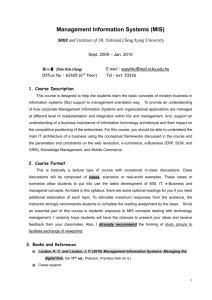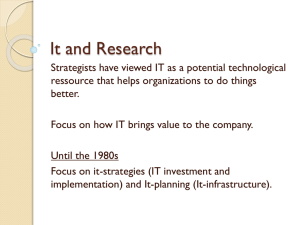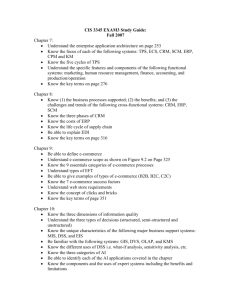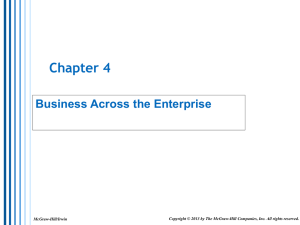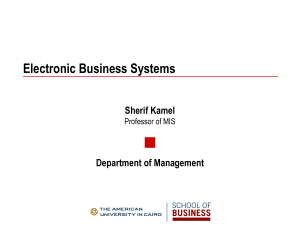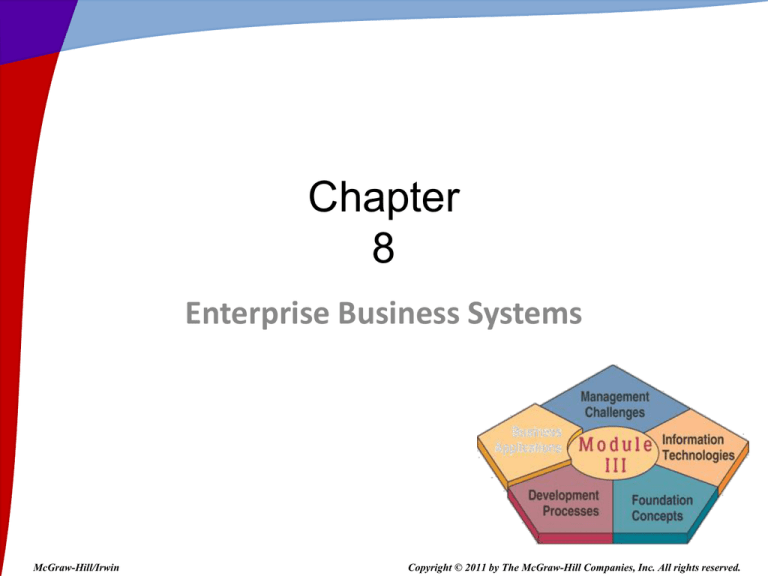
Chapter
8
Enterprise Business Systems
McGraw-Hill/Irwin
Copyright © 2011 by The McGraw-Hill Companies, Inc. All rights reserved.
Learning Objectives
• Identify and give examples to illustrate the
following aspects of customer relationship
management, enterprise resource management, and supply chain management
systems:
– Business processes supported
– Customer and business value provided
– Potential challenges and trends
• Understand the importance of managing at
the enterprise level to achieve maximum
efficiencies and benefits.
8-2
Managing at the Enterprise Level
• Lessons from Geese
– Importance of team work
– Encourage passion and energy
8-3
Customer Relationship Management (CRM)
• Customer focused
– Customer relationships – most valued asset
– Find and retain most profitable customers possible
• Company has
– Single, complete view of every customer
• Customers have
– Single, complete view of the company
• Integrates and automates customer-serving
processes
8-4
Contact and Account Management
• Track relevant data about
– Every past and planned contact with
prospects and customers
– Other business and life cycle events
• Data captured from touchpoints
– Telephone, fax, e-mail
– Websites, retail stores, kiosks
– Personal contact
8-5
RWC 1: CRM Goes Mobile
• Sales people
– Autonomous and don’t play by rules
– Ignore new processes unless direct benefit
• More sales
• Better time efficiency
• Designing Mobile Applications
– What are the common tasks
– What are the priorities
– What are the pain points
– Less is more
8-6
Application Clusters in CRM
8-7
Sales
• A CRM system provides:
– Support and manage sales activities
– Optimize cross-selling and up-selling
– Method to check account status and history
8-8
Customer retention evaluation report
8-9
Marketing and Fulfillment
• Automate direct marketing campaigns
– Qualifying leads for targeted marketing
– Scheduling and tracking mailings
– Capturing and managing responses
– Analyzing the business value of the campaign
– Fulfilling responses and requests
8-10
Customer Service and Support
• Shared database
– Requests for service are created, assigned,
and managed
– Call center software routes calls to agents
– Help desk software provides service data
and suggestions for solving problems
• Personalized support information
8-11
Retention and Loyalty Programs
• Statistics
– Costs 6 times more to sell to a new customer
– Unhappy customer will tell 8-10 others
– Boosting customer retention by 5 percent
can boost profits by 85 percent
– Odds of selling:
• Existing customer - 50 percent
• New - 15 percent
– 70 percent of customers will do business
again if problems are quickly resolved.
8-12
Retention and Loyalty Programs
• Primary objective - enhancing and
optimizing customer retention and loyalty
– Identify, reward, and market to the most loyal
and profitable customers
– Evaluate targeted marketing and relationship
programs
8-13
The Three Phases of CRM
8-14
Benefits of CRM
• Identify and target the best customers
• Real-time customization and personalization
of products and services
• Track when and how a customer contacts
the company
• Provide a consistent customer experience
• Provide superior service and support
8-15
CRM Failures
• Reasons for Failure
– Lack of senior management sponsorship
– Improper change management
– Elongated projects that take on too much, too fast
– Lack of or poor integration between CRM and core
business systems
– Lack of end-user incentives leading to poor user
adoption rates
– Lack of understanding and preparation -- # 1
– Not solving business process problems first
– No participation on part of business stakeholders
involved
8-16
Trends in CRM
8-17
What is ERP?
• Cross-functional enterprise system
– Integrated suite of software modules
– Supports basic internal business processes
•
•
•
•
•
•
Manufacturing
Logistics
Distribution
Accounting
Finance
Human resources
– Facilitates information flows
• Business
• Supplier
• Customer
8-18
RWC 2: ERPs Get a Second Lease on Life
• Old ERPs customized to fit individual needs
• Upgrades can’t be applied without testing and
modification
• New ERPs have new features and capability
• Some companies stay with old systems
• Some companies buy new, but avoid
customization
8-19
ERP Application Components
8-20
ERP Process and Information Flows
8-21
Business processes and functions of ERP
8-22
ERP at Colgate
• Needed to coordinate globally, act locally
• Order-to-delivery time cut in half
– Order acquisition and process
• 7 days cut to 4 hours
– Distribution
• 4 days cut to 14 hours
• Increased on-time deliveries
• Domestic inventories dropped by 1/3
8-23
Costs of Implementing a New ERP
8-24
Causes of ERP Failures
• Most common causes of ERP failure
– Under-estimating complexity
• Planning, development, training
– Failure to involve affected employees
– Too much too fast
– Insufficient training
– Insufficient data conversion and testing
– Over-reliance on ERP vendor or consultants
8-25
Trends in ERP
8-26
ERP application components
8-27
Supply Chain Management (SCM)
• Helps a company
–
–
–
–
–
Get the right products
To the right place
At the right time
In the proper quantity
At an acceptable cost
• Goal of SCM is to efficiently…
–
–
–
–
Forecast demand
Control inventory
Enhance relationships
Receive feedback
8-28
RWC 3: Supply Chains Adapt to Tough Times
• Old push model uses best-guess forecasts
– High inventory levels
– Supply chain stops during down-turn
• Key to survival in down-turn
– Reduced inventory
– Increased working capital
• Pull system
– Information to build inventory comes from supply
chain partners
– Inventory based on “demand signals”
8-29
Supply Chain Life Cycle
8-30
EDI Activities
8-31
Roles and Activities of SCM in Business
8-32
Functions and Benefits of SCM
8-33
Benefits of SCM
• Key Benefits
– Faster, more accurate order processing
– Reductions in inventory levels
– Quicker times to market
– Lower transaction and materials costs
– Strategic relationships with supplier
8-34
Challenges of SCM
• Key Challenges
– Lack of knowledge, tools, and guidelines
– Inaccurate data
– Lack of collaboration
– SCM tools are immature, incomplete, and
hard to implement
8-35
SCM at Emerson
• Emerson Transaction Hub
– Different orders in separate containers
– Created Transaction Hub (& Logistics Hub)
– Combine multiple orders into single
shipments/containers
8-36
Goals and Objectives of SCM
8-37
Trends in SCM
8-38
Trends in SCM
• CVS, McKesson
– CVS leading drug retail chain
– McKesson largest pharmaceutical distributor
– Point-of-sale data
– Agreed on service levels
– Reduced replenishment time
• Modern Plastics, SupplySolution, Inc.
– Upraded reactive system to proactive system
8-39
RWC 4: The Secret to CRM is in the Data
• CRM enables increased sales revenue
• CRM provides more and better services to
customers and prospects.
• CRM – better earlier than later.
• “Without accurate, complete, and
comprehensive data, any CRM effort will be
less than optimal.”
8-40



